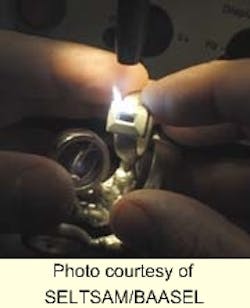STARNBERG, BAVARIA–Carl Baasel Lasertechnik GmbH, a manufacturer of Nd:YAG lasers such as the one shown here repairing a platinum ring, celebrated its 25th anniversary last October. Earlier this year, Rofin-Sinar (Hamburg, Germany) acquired 90% of the company, best known as a supplier of laser systems for marking. Rofin-Sinar subsequently announced that its subsidiaries now will be referred to under the common name of rofin—such as rofin Rofin Sinar and rofin Baasel Lasertech.
The rofin group is being restructured in line with its three main activities: the Macro Group, headed by Peter Wirth, will focus on sheet-metal processing for the automotive industry using high-power lasers such as CO2, Nd:YAG, and diode lasers; the Micro Group, led by Thomas Merk, will focus on electronics/IC, medical devices, jewelry, dental, and engraving using medium-power lasers; and the Marking Group, under Walter Volkmar, will address semiconductors, electronics, smart cards, consumer goods, and automotive parts using marking laser systems. Total sales of the new company are expected to be about $200 million.
Carl F. Baasel, founder of Carl Baasel Lasertechnik, will join the board of directors of the rofin group and will have responsibility for laser technology at rofin Baasel Lasertech.
Jewelry repair
Use of laser radiation for jewelry repair is not straightforward. A specially adapted beam with extended waist is needed so that the jeweler can position the area of the item to be processed into the focus of the beam by hand. In addition, to obtain good results the laser pulse lengths and energy must be adjusted to the requirements of copper, silver, gold, platinum, and their alloys. Once these parameters are known, the generation of repetitive ornaments, for example, minute gold beads sitting on a substrate, is speeded up.
Another benefit is that processing can be performed near precious stones without damaging them. In conventional processing, stones must be removed in advance and replaced after the process. Hence, "Starweld" lasers have become popular in the gold-manufacturing countries of the Near East.
About the Author
Uwe Brinkmann
Contributing Editor, Germany
Uwe Brinkmann was Contributing Editor, Germany, for Laser Focus World.
